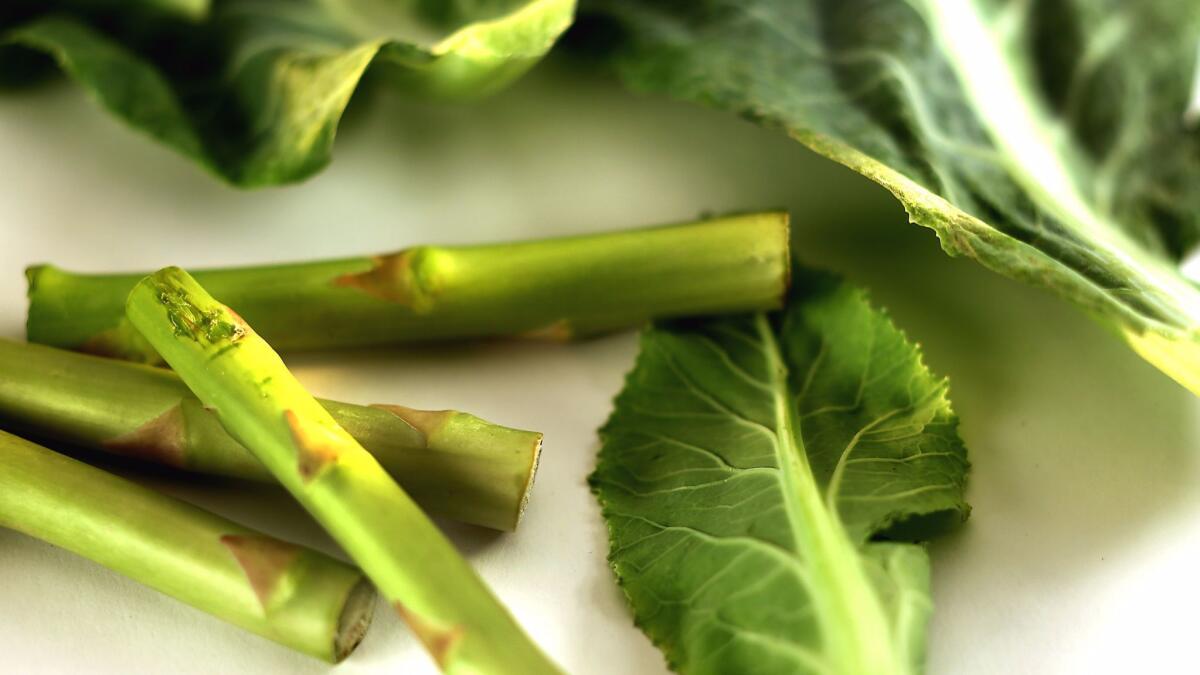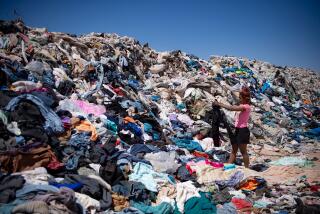Tackling global issues by targeting food waste

Chefs and scientists will discuss solutions for tackling the global problem of food waste at the Los Angeles Times Food Bowl, beginning May 1. For a full schedule of events, click here. In the story below, experts offer tips for reducing food waste in your own home.
Whatâs the point of worrying about organic food, genetically modified organisms, locally sourced items and fair trade if more than a third of it will simply go to waste? Discarded food is a serious issue, and itâs garnering attention from a variety of places. Statistics are stunning: Approximately 40% of food in America goes uneaten â the equivalent of $165 billion a year. Globally, itâs estimated that at least one-third of the worldâs food is wasted across the supply chain. Not only could curbing the waste have a profound effect on the very real issue of hunger but it could also help with less-obvious concerns â water supplies, energy and land use, even climate change.
In March, New York chef Dan Barber transformed his Greenwich restaurant Blue Hill into wastED, a three-week pop-up devoted to the theme of food waste and reuse. WastED collaborated with suppliers across the food chain, along with more than 20 guest chefs, to conceive dishes from food that would normally be discarded. In April, the documentary âJust Eat It: A Food Waste Storyâ premiered to American audiences. In it, filmmakers Grant Baldwin and Jen Rustemeyer pledge to live off of discarded food for six months, and through their journey they explore issues of waste across the food chain â from the farm, through retail and into a consumerâs refrigerator.
Every day, America wastes enough food to fill the Rose Bowl.
— Jonathan Bloom, in âAmerican Wasteland: How America Throws Away Nearly Half of Its Food (and What We can Do About It)â
âEvery day, America wastes enough food to fill the Rose Bowl,â writes Jonathan Bloom in the opening to his book âAmerican Wasteland: How America Throws Away Nearly Half of Its Food (and What We can Do About It).â
âFor the most part, we donât recognize weâre throwing away good food,â Bloom said recently, citing the disconnect when it comes to the amount of food wasted in individual households. Where most people may have a sense that there is a lot of waste society-wide, they donât implicate themselves as part of the problem. âThey donât tend to look in the mirror because itâs so easily disposed of. Itâs down the drain, itâs out with the trash or itâs sent back half-eaten at a restaurant.â
Before produce even has a chance to reach the average consumer, much of it is discarded merely because of imperfections in appearance.
âAround 6 billion pounds of produce is wasted each year because of looks,â says Ben Simon, a co-founder of Imperfect. The venture, scheduled to launch this summer, will take so-called ugly produce from Californiaâs Central Valley and distribute it to subscribers in Oakland and Berkeley at a discounted price.
âThe genesis [of wastED] was expanding the whole idea of what waste was,â says Barber, arguing that the American expectation of a plate of food is inherently wasteful. âWe cherry-pick what we want to eat instead of eating the whole thing.â
As Barber worked with other chefs in the wastED pop-up, he noticed that many were pulling ideas from items already on their menus. âBut they werenât calling it waste. Weâre talking fine dining.â Barber feels that restaurants and chefs should be credited for the creative work they do to make use of everything that comes into the kitchen. âWe get blamed for preciousness and elitism. We need to wear what we do on our sleeve. Chefs are doing this already.â
âI grew up doing this. We used everything; that was just a way of life,â says Michael Fiorelli, chef at Love & Salt in Manhattan Beach. âNow itâs funny to me that [itâs trendy].â Fiorelli has a dish on his menu made from sautĂŠed cauliflower leaves, served over a soft mascarpone polenta. The leaves are usually discarded after the vegetable is cleaned. âWhy would I throw the leaves in the trash? There are so many different ways to use them â just love them up a little.â
At Union Restaurant in Pasadena, chef Bruce Kalman infuses butter with the woody ends cut from asparagus. He uses it with his fingerling potato gnocchi. âI thought about all the flavors of spring and creative ways to add flavor. Itâs asparagus flavor without the asparagus. It eliminates food waste and enhances the flavor of the dish.â
Barber feels the conversation about food waste has only begun. âThis is a larger theme beyond just American waste. Where is the conversation going? Because the current conversation doesnât go far enough. Whatâs needed is a cultural shift.â
Tips for reducing food waste in the home
Shop smarter. âPrimarily itâs shopping smarter. Not bringing too much into your own home so you doom yourself to waste food. We squander 25% of the food we bring home.â â Jonathan Bloom, author of âAmerican Wastelandâ
Try to use every part of a food item you buy. âWe cherry-pick certain ingredients we want to eat instead of the whole thing. Waste should become gastronomic invention.â â Dan Barber, chef, author and creator of wastED
Donât just look for perfect produce in the stores. âWhen youâre grocery shopping, you can buy imperfect or buy the stuff no one else is going to buy. You can start that right now.â â Grant Baldwin, âJust Eat It: A Food Waste Storyâ filmmaker
Love your leftovers. âSave and actually eat the leftovers. Youâd be amazed how many people are so careful with packing everything up to get it into their refrigerator, only to let it rot once itâs there.â â Bloom
Avoid wasting meat, especially. âThe single biggest thing you can do is avoid wasting any meat at all, because the amount of water and land youâre wasting through this is disproportionately massive. Eat the whole thing.â â Tristram Stuart, author of âWaste: Uncovering the Global Food Scandalâ and founder of the environmental charity Feedback.
Manage your refrigerator. âWe donât need to fill our refrigerators front to back.â â Baldwin
Befriend your freezer. âUse it as a way to avoid waste. Pretty much every food item can be frozen.â â Bloom
Treat expiration dates as a guide. âTrust your senses, not the expiration date. Itâs not the ultimate arbiter of when a food should or shouldnât be eaten.â â Bloom
Push for your store to donate leftover unsold food. âGrocery stores are realizing they need to do something about it. I think at some point, people will pressure them with what they expect, just as they expect to see local and fair trade food. Theyâll expect to see theyâre donating food.â â Baldwin
Order only what youâll eat at restaurants. âWhen youâre out, maybe just say, âI donât need full portions.â If you donât need fries because youâre on an Atkins Diet, then donât have them placed on the plate.â â Baldwin
Compost. âComposting has a role. Itâs great keeping that stuff out of the landfill, and it has a real role in raising awareness in how much food weâre throwing away as a household and as a society.â â Bloom
Consider your place in the global food system. âOnce you connect your daily food choices â what you buy, where you buy it, whether you eat it all or throw it away â to the global phenomenon and you accept it, itâs not so much what you do. Itâs really who you are.â â Stuart
More to Read
Eat your way across L.A.
Get our weekly Tasting Notes newsletter for reviews, news and more.
You may occasionally receive promotional content from the Los Angeles Times.











